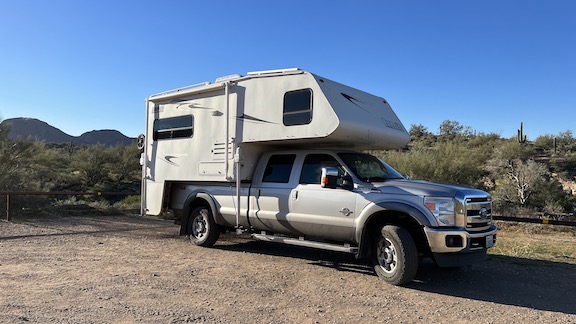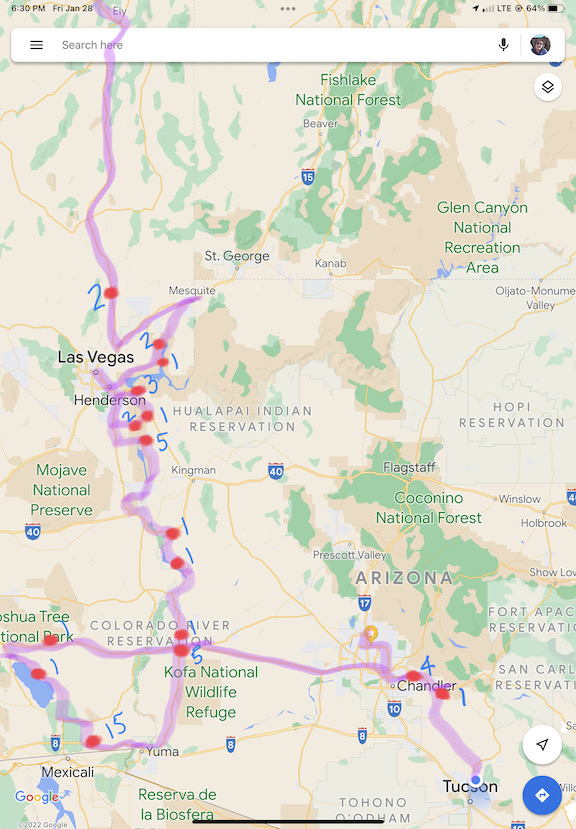Another video blog entry from my trip.
I’ll let the video say it all. Here it is, followed by the script I was so obviously reading. (Sorry! I’ll work on eye contact.)
Greetings! Maria here with Lily and Rosie the dogs and Turtleback 2, my trusty truck camper, reporting in from the BLM Holtville Hot Springs near Holtville, California.
We got here nearly a week ago, looking for a warm place to spend a few days. I’ve been coming here for the past six or so years — although I didn’t come last year — so I know the place pretty well. The hot springs is at a BLM Long Term camping area. That means you can pay $40 to camp for up to two weeks or $160 to camp for up to 7 months. I paid for the two-week pass, even though I only expected to stay a few days.
The campground is inhabited by mostly retired folks in all kinds of rigs. Most of them are decked out with solar panels for power. There are also some full-time RVers who either live here a few months or pass through like I do. The campsites are nicely spread out and relatively private. The place is quiet because most folks don’t use generators and it’s not the kind of place that would appeal to rowdy folks.
The main feature here is the hot springs, which is just outside the camping area unfortunately close to Interstate 8. The soaking area consists of three tubs. The large one is very deep — I’m 5 foot 8 and it goes to my shoulders — and usually the hottest one. That one’s overflow goes into a smaller tub that’s shallow and is usually the coolest of the bunch. Those two are both concrete. The third one, which is new to me, is a standard stock tank that can comfortably seat three people; its temperature varies on how recently it was filled.
The hot water comes into the tanks from a Frankenstein’s monster of pipes, valves, and hoses. Below the surface of the largest tub is the valve with the hottest water because it’s closest to the source. From there, the water also goes up a vertical pipe to feed another valve with cooler water (because it’s going through the air before it hits the tub) and finally a rotating shower head. Along the way, there’s a valve and a hose to feed the stock tank.
The whole setup is cleaned weekly on Tuesday mornings by a team of volunteers from the campground using a truckload of equipment. They drain all tanks and use a power washer to clean their surfaces. In the old days, they used to put spa chemicals into it, but they don’t do that anymore. Now they just refill the tanks and they’re good to go for another week. Because fresh water can always be added, the water flushes through nicely and doesn’t really get too gross.
All of the area’s overflow drains into a beautiful pond surrounded by palm trees. I used to see ducks in here, but I haven’t seen any so far this year.
I recommend this place if you don’t mind a more rugged hot springs experience. The tubs are nice but they are shared. Clothing is required — if you strip down, you will be asked to dress. You’re also expected to shower before entering any of the tubs. Common courtesy prevails.
There are a number of hot springs sources in the area. Nearby, there’s a geothermal plant that I can sometimes hear humming if I go out at night and there’s supposed to be another hot spring about 10 or so miles north of here that isn’t quite as nice as this.
My pups and I will be here a day or two longer. This has been my most pleasant stop so far, with great weather, lots of sun, two hot tub soaks a day, and plenty of biking and walking. And the Internet access on my mobile devices is wicked fast. I’m not looking forward to moving on.
Let me know what you think about this video in the comments. If you’d like to see more — including livestream video from Quartzsite, AZ during the big rock shows — please subscribe! And check out my blog for more details about my winter travels this year.
See you!


